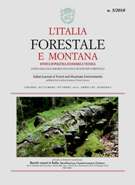Special section
Published 2013-05-16
Keywords
- dead wood,
- decay,
- forest dynamic,
- beech,
- silver fir
- structure ...More
Copyright (c) 2013 Italian Journal of Forest and Mountain Environments

This work is licensed under a Creative Commons Attribution-NonCommercial 4.0 International License.
Abstract
This study was carried out in the “La Verna” forest, located in the “Foreste Casentinesi, Monte Falterona, Campigna” National Park at the border between Arno and Tevere watersheds. The forest covers an area of 203 ha and it is owned by the Franciscan religious order. Since 1985 the “La Verna” forest has been managed by the “Casentino” Comunità montana.In 2008 a sector of about 36 ha was selected for an intensive study of the stand structure, and the quality and quantity of coarse woody debris (CWD). A regular network of 33 sampling point was established.
The average stem density was 473 trees ha-1 (range 133-1283) and the growing stock of living trees was 657.1 m3ha-1 (299-1452.9). The average volume of CWD was 66.9 m3ha-1 ranging between 3.7 and 355.8 m3ha-1. Of the total volume of dead and living trees, CWD comprised 10.2%. Among the CWD the volume of logs (66.1%) was greater than the volume of snags (28.3%) and stumps (5.6%).
The study has emphasized that the “La Verna” forest, besides the historical and cultural value, has an important naturalistic value. The past low-intensity silviculture, traditionally applied by the Franciscan monks, has allowed the development of the current mixed structure and the co-existence in a managed forest of some structural “old-growth” characteristics e.g. the multi-layered vertical structure, the high living biomass and the
quantity and quality of CWD.

